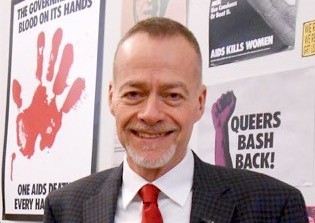September marks National Recovery Month—as in recovery from substance abuse—so what better time to talk about David Fawcett’s enlightening read Lust, Men and Meth: A Gay Man’s Guide to Sex and Recovery.
I discovered the book last December when Fawcett, a psychotherapist in Fort Lauderdale, stopped by the Bureau of General Services—Queer Division, a supercool bookstore and event space nestled inside the LGBT Center of Manhattan. In his book tour/lecture series, Fawcett explained to us why the fusion of sex and meth is so dangerous and what the recovery process is like for meth addicts.
He’s an engaging and accessible speaker, and his book reads exactly like that. Though packed with research data and science, Lust, Men and Meth never gets bogged down in academic lingo. Even better, it’s filled with real-life experiences culled from Fawcett’s practice and you’ll find an introduction by POZ blogger Mark S. King.

David Fawcett, PhD, author of “Lust, Men and Meth,” December 2015Public Impact Media
With clarity and insight, Fawcett lays out how meth increases a person’s risk for HIV and why the drug holds such an appeal to certain gay men as well as to segments of the HIV population. He explains that crystal affects our ability to organize, make deadlines and solve problems, and it influences our perceptions of love and lust, self-esteem, vulnerability, attractiveness, etc. (And yes, you’ll find sections on “crystal dick”—the phenomenon of feeling super horny but not being able to get an erection—and on the ways meth can increase our desire for rougher sex, extreme porn or cybersex.)
Taking a wider view of its topic, the book explores fascinating theories about sexual health and erotic desire, like psychologist Jack Morin’s “four cornerstones of eroticism,” which play into the creation of our individual sexual templates.
“Sex becomes an opportunity,” Fawcett writes at one point, “to find and cultivate self-worth and love for oneself. Personal erotic scripts and themes derive from our life experiences and reveal much about our fears, needs and capability to meet those needs.”
Fascinating stuff for anyone—not just gay men or meth users or people living with HIV.
Just how powerful is meth?
As Fawcett explains, research shows that eating food stimulates the release of about 150 units of dopamine (a naturally occurring neurotransmitter associated with pleasure and reward). Sex releases about 200 units. Nicotine clocks in at 250 units (no wonder it’s hard to kick cigarettes), and cocaine releases 350 units. Keep in mind that these substances are natural, whereas meth is manmade. And how much dopamine does meth release? A whopping 1,100 units, nearly three times that of cocaine.
But unlike cocaine, for example, meth stays in the body longer and ultimately destroys the brain’s neurons. “This explains the long process required for recovery of cognitive skills, especially verbal, after the user is abstinent from meth,” Fawcett writes. “The brain must literally ‘rewire’ by creating new neural pathways, a process that can take up to 24 months….” But normal dopamine levels, he says, begin to reappear after a year or more of abstinence.
The ability of the brain to rewire, Fawcett writes, is referred to as neuroplasticity: The brain is plastic. In other words, new research shows that our brains are more adaptive than previously thought. This is particularly good news for people in recovery—over time, they can mend some of the damage. But it’s a long and arduous journey (one that usually requires a period of celibacy).
Wow. For me, this really puts the recovery process into perspective and gives me more empathy for anyone on this journey.
For more about this topic, read Mathew Rodriguez’s POZ cover story “After Party: Why Does Crystal Meth Still Attract Gay Men?” and visit David-Fawcett.com.

A display at the Bureau of General Services—Queer Division, located inside Manhattan’s LGBT Center, December 2015Public Impact Media








1 Comment
1 Comment